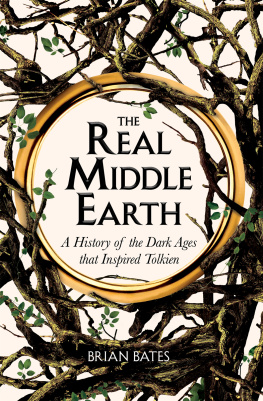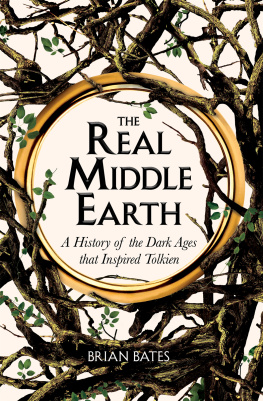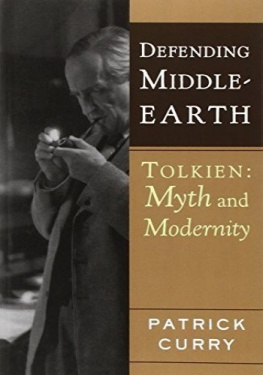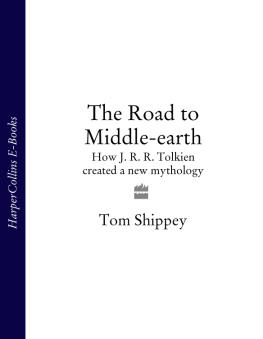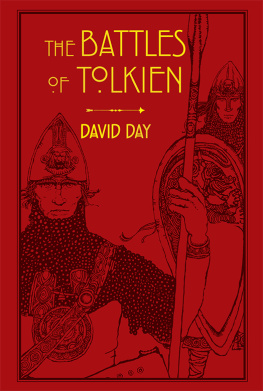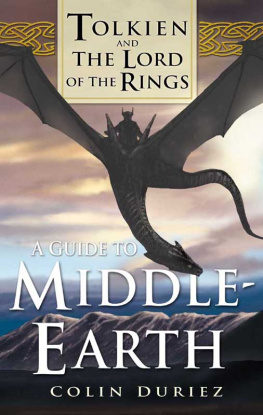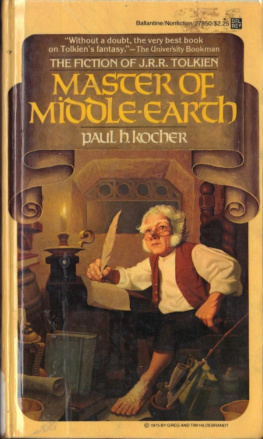THE REAL
MIDDLE-EARTH
A History of the Dark Ages that Inspired Tolkien
BRIAN BATES

Contents
Acknowledgements
The Real Middle-earth is a subject that rambles like the roots of a great oak well beyond the boundaries of conventional disciplines. Over the decades spent researching this fascinating topic I have benefited from the generous help of people who have each, in their ways, explored the territory. It started with that great British writer on Zen and Tao, Alan Watts, who, from his retreat on Mount Tamalpais, encouraged me to rediscover the magic and mystery of ancient England. And then I was fortunate to have the advice, wisdom and Glaswegian humour of the eminent psychiatrist R. D. Laing. Both these men are long gone to the Otherworld, but I still honour their wit, their shapeshifting, and our many discussions into the wee hours.
Much more recently, friends and colleagues who advised me are legion; they know who they are, and I thank them all. I have space to mention a few, starting with anthropologist Dr Susan Greenwood, who teaches Shamanic Consciousness with me at the University of Sussex. I am grateful for her informed views on imaginal states of mind, and for her letting me read the draft of her forthcoming book Nature, Religion, and Magical Consciousness. Historian John Russell engaged with me in many lively and humorous discussions on the nature of historical evidence, the powers of wizards, and perspectives on Tolkiens Middle-earth. Romani spiritual teacher (chovihano) Jasper Lee, and Lizzie Gotts, introduced me to the little folk of the Jal tradition, and I am also grateful for Jaspers healing presence after the car accident. Oneida tribal elder Professor Apela Colorado shared with me her profound understanding of the spiritual worlds of indigenous peoples and provided inspiring and practical support for my work in rediscovering knowledge from ancient Europe; stained-glass artist and sacred landscapes researcher Kathy Shaw kindly took me to visit the ancient yew of Ankerwyke and outlined her fascinating insights into the imagination-charged environment of ancient times; architect Susanne Nessensohn shared with me her visions of the Celtic Otherworld, and also her sensitive insights into King Redwald; and anthropologist Dr Merete Jakobsen provided invariably stimulating discussions of her research into shamans, the implications of magic and the enchantment of stories.
For sustaining me throughout the writing I am grateful to Rachel Turner for her superb coaching; my literary agent Ed Victor, and my editors at Macmillan, Gordon Wise and Ingrid Connell, for knowledgeable advice and encouragement throughout. Also thanks to Jacqui Butler for her resourceful picture research. Last but not least, my family; Beth, Pearl and Robin unfailingly provided me with great ideas and loving support.
Illustration Acknowledgements
National Trust Photographic Library / Joe Cornish
Ancient Art and Architecture Collection
Roman Baths, Bath and North East Somerset Council
Brian Bates
St Edmundsbury Borough Council / West Stow Anglo-Saxon Village Trust
Werner Forman Archive
Michael Holford
AKG London
J. S. Selfe
National Trust Photographic Library / Ray Hallett
British Library, MS Harley 603, fol. 22r
Antikvarisk-topografiska arkivet, the National Heritage Board, Stockholm
Sheffield Galleries & Museums Trust
National Museum of Denmark

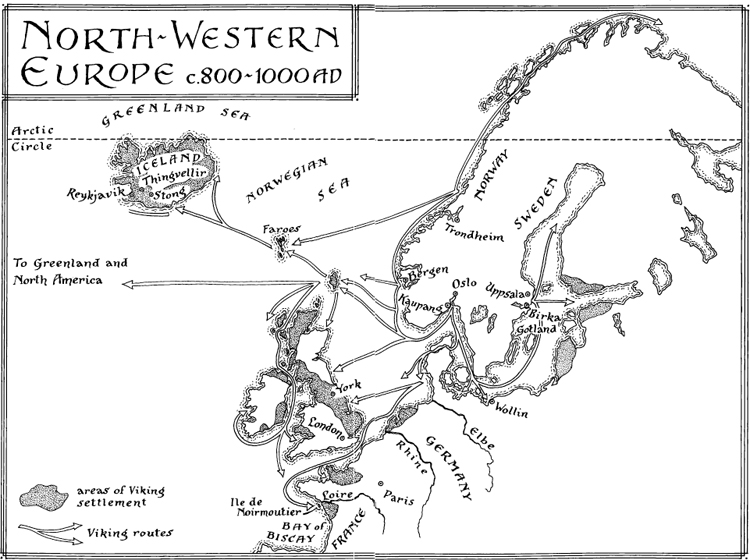
REDISCOVERING
THE REAL MIDDLE-EARTH
1. The Real Middle-earth
The gods and goddesses lived in the bright spaces of the Upperworld, along with the light elves. Far beneath, in the cavernous shadows of the Lowerworld, lurked the spirits of the dead; they were accompanied by dark elves and the dragon called Nidhog. And in between, reached by a bridge formed of a rainbow called Bifrost (Trembling Pathway), lay the enchanted landscape of Middle-earth. It was a magical realm inhabited by men and women, and surrounded by an infinite ocean. In the ocean swam a serpent so huge he encircled all of Middle-earth and bit on his own tail. In the mountains bordering the ocean lived the giants. This landscape of three realms, one above the other, is how the peoples of historical north-west Europe saw their world during the first millennium, that early period sometimes called the Dark Ages (so-called by scholars to mark the relative lack of written records during the first thousand years of English history, and the absence for several centuries of Christianity). The great cultures of those times, the Celts, Anglo-Saxons and Norse, infused their lives with a remarkable imagination and sense of spirituality. The natural landscape of Europe took on a whole new meaning a deeper, enchanted dimension, making it a realm of magic and mystery. These were the people of the Real Middle-earth.
Today, the term Middle-earth conjures a fictional realm of spirits and sorcery made famous by J.R.R. Tolkiens epic fantasy The Lord of the Rings. His invented tales of the wizard Gandalf, Bilbo Baggins, the hero Aragorn, the fire-demon Balrog, rings of power, Queen Galadriel, quests through ancient and evocative landscapes the whole fantastical world of magic and adventure have made his among the most popular novels over the last fifty years.
But now there is another remarkable story to be told: Middle-earth really existed. Historical research has revealed that, stretching from Old England to Scandinavia and across to western Europe, there arose about two thousand years ago a largely forgotten civilization which foreshadowed Tolkiens imagined world. Tolkien readily admitted in his letters that the concept of Middle-earth was not his own invention, but an old Anglo-Saxon term for the magical world inhabited by people in the first millennium ( AD 01000). And it is this culture, made up of many colourful early European tribes now identified under the umbrella titles of Celts, Anglo-Saxons and Norse, on which he based The Lord of the Rings.
Until recently, historians tended to regard these peoples as primitive, violent and obscure barbarians, living in the shadows of the more widely documented Romans who formed an empire over all of Europe in those early times. But research in a wide range of disciplines is revolutionizing our view of the past. We now realize that at their best these ancient civilizations were characterized by some remarkable perspectives on the nature of reality.
The people of the Real Middle-earth had a vision of life animated by beings beyond the material world elves, dwarves, giants and fire-breathing dragons. They believed that real wizards cast spells, and flew on eight-legged horses. A life-force enchanted everything. Berserker warriors were believed to change into bears, and heroes journeyed on perilous quests for truth in the land of the giants. The cosmos was held together by an interlaced web of golden threads visible only to the wizards. And at the centre of it all lay Middle-earth, inhabited by people and suffused with a magical power.
While their many tribal cultures were rich and varied (and in this book I point out some of the differences between them), in comparison with the twenty-first century their commonalities were strong. Even in the mundane realities of everyday life, these peoples of ancient Europe shared the experience of living in a natural, un-engineered world markedly different from today. In particular, their imaginative and inspired view of life makes these people sufficiently homogeneous for us to approach their remarkable cultures as a single destination for a journey back in time.

